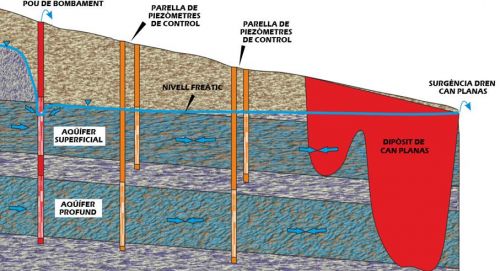
02/10/2020
The hydraulic barrier of Can Planas comes into operation
The hydraulic barrier of Can Planas comes into operation
The Parc de l'Alba —whose business area is the Barcelona Synchrotron Park— a set of green areas (half of the total surface of the park) with an emblematic biological corridor and, at the same time, a future residential area.
An old landfill called Can Planas, located in the green areas of the Park, is being remedied with a first action - a hydraulic barrier - which came into operation on September 23.
The Can Planas landfill is a set of clay extraction basins filled, between the 70s and the 90s, with different types of waste. It occupies a total of 18 hectares and a volume of 2.45 million m3. In 1995, it was closed down by the Barcelona Metropolitan Area (AMB), which has been in charge of the post-closure phase ever since. The document available here (in Catalan) tells the whole set of actions carried out to make this damaged space a new and large healthy green space.
On the basis of the actions proposed by the hydrogeological and gas reports and the quantitative risk analysis, the AMB has carried out the work on the hydraulic barrier that must minimize the entry of clean subway water into the landfill, thus reducing the output of leachate downstream and through the drainage system of Can Planas (see the image illustrating the news).
The proposed operation of the hydraulic barrier was agreed and validated by the ACA (Catalan Waste Agency) in a resolution available here (in Catalan) dated 9/07/20. This resolution requires the creation of a working group with decision-making capacity that will supervise its proper functioning. This working group includes technicians from the AMB, the ACA, the ARC (Catalan Waste Agency), the Cerdanyola City Council and the Consortium that manages the park.
The commissioning of the hydraulic barrier has been carried out following the protocol established and validated by the ACA, which also incorporates a protocol for starting and stopping the pumping according to the measured values of the phreatic levels, electrical conductivity and complete analytical control of the groundwater.
This barrier is the first step towards improving the environment of the Can Planas landfill, which will continue with the installation of a surface sealing layer, among other improvement actions, and the subsequent and definitive implementation of the Parc de la Plana del Castell. Soil recycling, developing new green areas in conditions of safety and health for citizens and the environment, plays a central role in the sustainable governance of soil as a strategic natural resource and is within the objectives of the 7th Environmental Action Programme of the European Union.
An old landfill called Can Planas, located in the green areas of the Park, is being remedied with a first action - a hydraulic barrier - which came into operation on September 23.
The Can Planas landfill is a set of clay extraction basins filled, between the 70s and the 90s, with different types of waste. It occupies a total of 18 hectares and a volume of 2.45 million m3. In 1995, it was closed down by the Barcelona Metropolitan Area (AMB), which has been in charge of the post-closure phase ever since. The document available here (in Catalan) tells the whole set of actions carried out to make this damaged space a new and large healthy green space.
On the basis of the actions proposed by the hydrogeological and gas reports and the quantitative risk analysis, the AMB has carried out the work on the hydraulic barrier that must minimize the entry of clean subway water into the landfill, thus reducing the output of leachate downstream and through the drainage system of Can Planas (see the image illustrating the news).
The proposed operation of the hydraulic barrier was agreed and validated by the ACA (Catalan Waste Agency) in a resolution available here (in Catalan) dated 9/07/20. This resolution requires the creation of a working group with decision-making capacity that will supervise its proper functioning. This working group includes technicians from the AMB, the ACA, the ARC (Catalan Waste Agency), the Cerdanyola City Council and the Consortium that manages the park.
The commissioning of the hydraulic barrier has been carried out following the protocol established and validated by the ACA, which also incorporates a protocol for starting and stopping the pumping according to the measured values of the phreatic levels, electrical conductivity and complete analytical control of the groundwater.
This barrier is the first step towards improving the environment of the Can Planas landfill, which will continue with the installation of a surface sealing layer, among other improvement actions, and the subsequent and definitive implementation of the Parc de la Plana del Castell. Soil recycling, developing new green areas in conditions of safety and health for citizens and the environment, plays a central role in the sustainable governance of soil as a strategic natural resource and is within the objectives of the 7th Environmental Action Programme of the European Union.
More news
10/06/2015
The Barcelona Synchrotron Park in the SmartReFlex European project
01/06/2015
SENER and ALBA sign a technology transfer agreement
28/05/2015
Synchrotron light applications for the pharmaceutical industry
20/05/2015
Financial Times ranks ESADE 7th worldwide in open executive education programmes
14/05/2015
Joint promotion in Korea of the Barcelona Synchrotron Park and the Parc Científic de Barcelona
07/05/2015
The UAB ranks well









